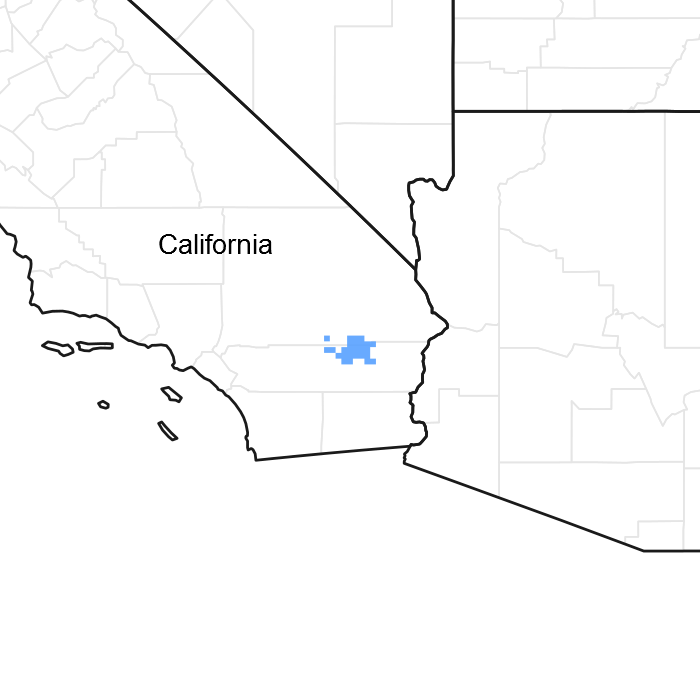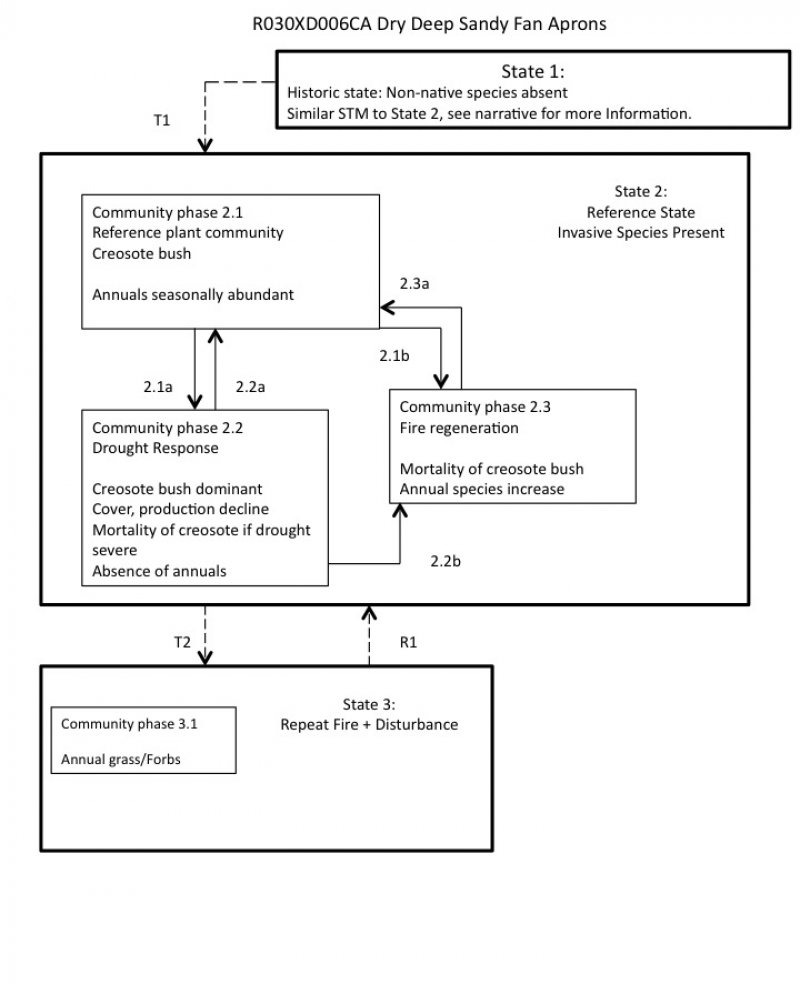

Natural Resources
Conservation Service
Ecological site R030XD006CA
Abandoned Fan
Last updated: 10/21/2024
Accessed: 12/22/2024
General information
Provisional. A provisional ecological site description has undergone quality control and quality assurance review. It contains a working state and transition model and enough information to identify the ecological site.

Figure 1. Mapped extent
Areas shown in blue indicate the maximum mapped extent of this ecological site. Other ecological sites likely occur within the highlighted areas. It is also possible for this ecological site to occur outside of highlighted areas if detailed soil survey has not been completed or recently updated.
MLRA notes
Major Land Resource Area (MLRA): 030X–Mojave Basin and Range
The Mojave Desert Major Land Resource Area (MLRA 30) is found in southern California, southern Nevada, the extreme southwest corner of Utah and northwestern Arizona within the Basin and Range Province of the Intermontane Plateaus. The Mojave Desert is a transitional area between hot deserts and cold deserts where close proximity of these desert types exert enough influence on each other to distinguish these desert types from the hot and cold deserts beyond the Mojave. Kottek et. al 2006 defines hot deserts as areas where mean annual air temperatures are above 64 F (18 C) and cold deserts as areas where mean annual air temperatures are below 64 F (18 C). Steep elevation gradients within the Mojave create islands of low elevation hot desert areas surrounded by islands of high elevation cold desert areas.
The Mojave Desert receives less than 10 inches of mean annual precipitation. Mojave Desert low elevation areas are often hyper-arid while high elevation cold deserts are often semi-arid with the majority of the Mojave being an arid climate. Hyper-arid areas receive less than 4 inches of mean annual precipitation and semi-arid areas receive more than 8 inches of precipitation (Salem 1989). The western Mojave receives very little precipitation during the summer months while the eastern Mojave experiences some summer monsoonal activity.
In summary, the Mojave is a land of extremes. Elevation gradients contribute to extremely hot and dry summers and cold moist winters where temperature highs and lows can fluctuate greatly between day and night, from day to day and from winter to summer. Precipitation falls more consistently at higher elevations while lower elevations can experience long intervals without any precipitation. Lower elevations also experience a low frequency of precipitation events so that the majority of annual precipitation may come in only a couple precipitation events during the whole year. Hot desert areas influence cold desert areas by increasing the extreme highs and shortening the length of below freezing events. Cold desert areas influence hot desert areas by increasing the extreme lows and increasing the length of below freezing events. Average precipitation and temperature values contribute little understanding to the extremes which govern wildland plant communities across the Mojave.
Hyper-Arid Mojave Land Resource Unit (XD)
LRU notes
The Mojave Desert is currently divided into 4 Land Resource Units (LRUs). This ecological site is within the Hyper-Arid Mojave LRU, extremely hot and dry low elevation troughs within the Mojave Desert. The Hyper-Arid Mojave LRU is designated by the 'XD' symbol within the ecological site ID. This LRU is found within the Death Valley/Mojave Central Trough, as well as portions of the Mojave exposed to the Salton Sea Trough and the Colorado River Valley. This LRU is essentially equivalent to the Death Valley/Mojave Central Trough, Arid Valleys and Canyonlands, and associated Mojave Sand Dunes and Mojave Playas of EPA Level IV Ecoregions.
Elevations are predominantly below 1650 feet with precipitation is less than 4 inches per year. Mountain slopes within the watersheds of these low elevation troughs may extend up to approximately 2460 feet (750 m). This LRU is distinguished by its extremely aridity where a nearly barren landscape is occupied by widely spaced shrubs. Vegetation includes creosote bush, burrobush, big galleta grass with many annual species able to take advantage of infrequent precipitation events which occur in this LRU. Playa species such as Mojave seablite and saltbush species are also common in this LRU.
Classification relationships
Mojave Creosote Bush (Holland, 1986)
Larrea tridentata Shrubland Alliance (Sawyer et al. 2009).
Ecological site concept
Ecological Site Concept –
This ecological site occurs on abandoned alluvial fans and fan aprons with soils which are very deep, and are composed of layers of sand, coarse sand and loamy sand with varying amounts of gravel and cobbles. This ecological site tends to occupy distal fan positions, far from sources of run-on, and this site typically has no sheet-flow from flash-flooding events.
Production reference value (RV) is 67 pounds per acre, and ranges from 21 to 191 pounds per acre depending on annual precipitation and annual forb production. Vegetation is sparse, and dominated by low-statured creosote bush (Larrea tridentata). A hyperthermic climate with deep sandy soils with no additional run-on from sheet flooding drives the vegetation community of this ecological site. The deep-rooted creosote bush is the only shrub capable of tolerating the extremely arid conditions.
The data in the following sections is from major (15% of mapunit or greater) components only.
This is a group concept and provisional STM that also covers R030XD042CA.
Associated sites
| R030XD039CA |
Coarse Gravelly Fans This ecological site is found on adjacent occasionally flooded alluvial fans. Creosote bush (Larrea tridenata), burrobush (Ambrosia dumosa) and brittlebush (Encelia farinosa) are dominant. |
|---|---|
| R030XD004CA |
Low-Production Hyperthermic Hills This ecological site is found on steep sideslopes of adjacent fan remnants. Sparse vegetation is dominated by creosote bush (Larrea tridentata). |
| R030XD008CA |
Hyperthermic Sandhill This ecological site is found on adjacent sandhills. Big galleta (Pleuraphis rigida) and creosote bush (Larrea tridentata) are dominant. |
| R030XD014CA |
Hyperthermic Sandy Plains This ecological site is found on adjacent semi-active sandsheets. Big galleta (Pleuraphis rigida) is dominant. |
| R030XD015CA |
Hyper-Arid Fans This ecological site is found on adjacent fan aprons with rare surface flooding. Creosote bush (Larrea tridentata) and burrobush (Ambrosia dumosa) dominate. |
| R030XD025CA |
Hyperthermic Sandsheets This ecological site is found on adjacent sandsheets. Creosote bush (Larrea tridentata) and big galleta (Pleuraphis rigida) dominate. |
| R030XD042CA |
Hyperthermic Shallow To Moderately Deep Fan Remnants This ecological site is found on adjacent very stable fan remnants. Creosote bush (Larrea tridentata) is dominant. |
| R030XY001CA |
Occasionally Flooded, Hyperthermic, Diffuse Ephemeral Stream This ecological site is found on adjacent occasionally flooded drainageways. Creosote bush (Larrea tridentata) and Schott's dalea (Psorothamnus schottii) dominate. |
| R030XY092NV |
DESERT PATINA This ecological site is found on adjacent fan remnants with desert pavement surface. Very sparse vegetation is dominated by creosote bush (Larrea tridentata). |
Similar sites
| R030XD015CA |
Hyper-Arid Fans This ecological site occurs on landform positions receiving more surface flooding. This site is more productive, shrub density is higher, and burrobush (Ambrosia dumosa) is co-dominant with creosote bush (Larrea tridentata). |
|---|---|
| R030XD042CA |
Hyperthermic Shallow To Moderately Deep Fan Remnants This ecological site occurs on very stable fan remnants with a high degree of soil horizon development. It has lower production and shrub density. |
Table 1. Dominant plant species
| Tree |
Not specified |
|---|---|
| Shrub |
(1) Larrea tridentata |
| Herbaceous |
(1) Plantago ovata |
Click on box and path labels to scroll to the respective text.

